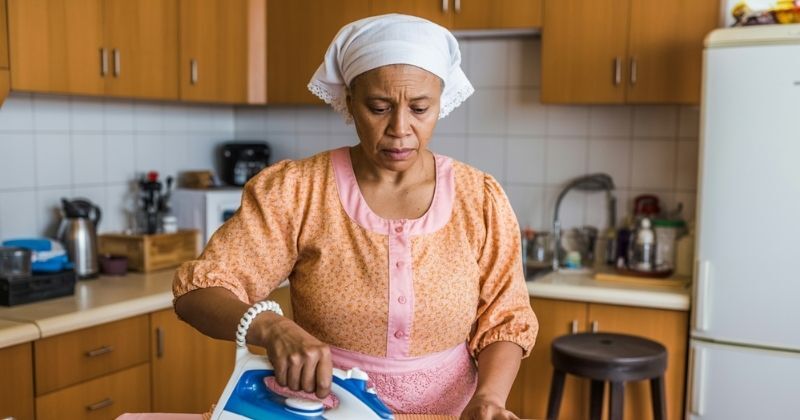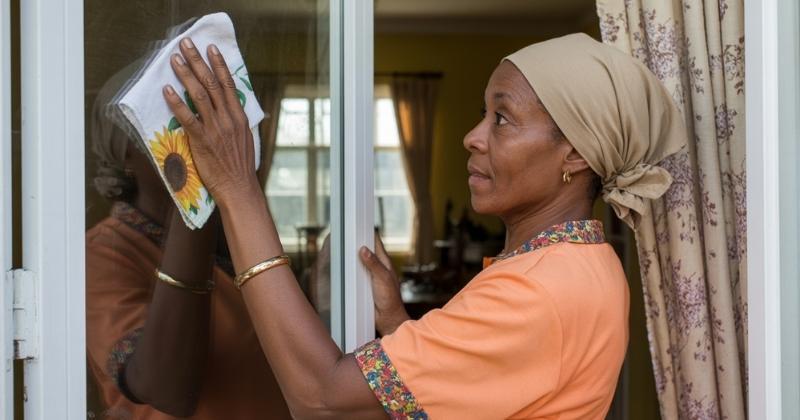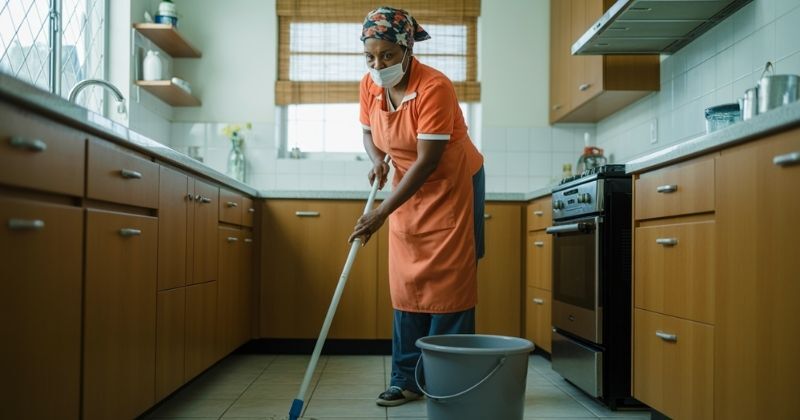
The most recent labour statistics released by Statistics South Africa indicate that employment for domestic workers continues to contract, even as many of these workers struggle under intensifying financial strain. Although the sector recorded a modest increase in jobs compared with the previous quarter, the broader year-on-year comparison reveals a continued downward trajectory from the second quarter of 2024.
Key Takeaways
- Domestic Worker Job Decline: Despite a small quarter-on-quarter increase in employment, South Africa has lost around 160,000 domestic worker jobs since the pandemic, representing a 17% drop and highlighting long-term instability in the sector.
- Severe Financial Strain: Women earning under R5 000 a month, the majority of whom are domestic workers, face extremely high debt-to-income ratios of 94%, with most of their income consumed by loan repayments, leaving households with little disposable income.
- Wages and Mental Health Concerns: While the legal minimum wage sets pay at R28.79 per hour, actual earnings are often far lower, averaging just R3 349 per month, which contributes to heightened stress, depression, and anxiety for workers supporting entire households.
About Arcadia Finance
Arcadia Finance makes borrowing stress-free. With zero application fees and access to 19 NCR-registered lenders, you’ll benefit from a safe, reliable process and options suited to your unique financial situation.
The data highlights not only a steady decline in employment opportunities for domestic workers but also shows that this key group, primarily women earning less than R5 000 per month, is under extreme financial stress according to various financial assessments. Many of these women are single parents or primary caregivers, meaning that the erosion of their earning potential directly impacts children’s nutrition, access to education, and general household stability.
Quarterly Labour Force Survey Findings
The Quarterly Labour Force Survey (QLFS) for the second quarter of 2025 reported that employment in the domestic worker sector rose by approximately 21,000 positions between April and June of the year. This represents a 2.5% quarter-on-quarter increase, bringing the total to around 839,000 jobs. Despite this, the figures are still 0.5% lower than the same period in 2024, reflecting a year-on-year decline of 4,000 positions.
In practical terms, these statistics reveal that while certain households may be hiring again, the overall demand for domestic services is shrinking, leaving many workers with only partial employment or unstable working hours.
Longer-term data indicates that South Africa has permanently shed close to 160,000 domestic worker positions since the onset of the Covid-19 pandemic, which equates to a 17% reduction in overall jobs within the sector. This represents a structural change rather than a temporary dip, as households have permanently adjusted by relying less on domestic labour, often because of their own financial challenges.

Broader Job Losses Since the Pandemic
Industry perspectives paint an even more severe picture. SweepSouth, a platform specialising in domestic work placements, points to a much higher pre-pandemic employment base of approximately 1.2 million workers. By contrast, employment numbers dropped sharply after the pandemic to around 850,000, and in 2025 figures fluctuate between 800,000 and 850,000, with the overall trend continuing downward. This confirms that the once-stable domestic work sector, long regarded as an entry point for women into the economy, has experienced a permanent contraction.
According to these figures, roughly 21% of domestic workers lost their employment completely, while 36% have lost partial employment. This decline represents a profound structural shift in the sector that shows little sign of reversing. What makes this situation more severe is that these percentages translate to hundreds of thousands of families losing their only predictable income stream.
A Worsening Situation for Workers
SweepSouth’s leadership has described the plight of domestic workers as serious and deteriorating, citing the combined effects of declining job opportunities, reduced income levels, and the growing burden of mental health difficulties. A large part of the psychological distress is directly linked to worsening financial conditions, with debt and insecurity adding significant weight to an already difficult reality.
Mental health specialists are also warning that this combination of debt, unemployment, and caregiving responsibilities has the potential to create a “silent crisis” of untreated anxiety and depression among working-class women.
The severity of the issue is compounded by the fact that many domestic workers are the primary earners in their households. With an average of four dependants relying on their income, the pressure to provide basic needs such as food, shelter, and education has reached critical levels. This multiplier effect means that every lost job does not only affect the worker, but an entire household ecosystem that depends on their wages for survival.
Rising Financial Pressures
Evidence from financial research supports the view that domestic workers are buckling under escalating money-related stress. DebtBusters, a financial advisory and debt management company, has conducted studies that track both stress levels and debt ratios among South Africans. Its Money Tracker for July 2025 revealed that women earning under R5 000 per month form the group most anxious about their personal finances. The situation has become so pressing that debt counsellors now report an influx of applications from this income group, signalling a desperate attempt to restructure unmanageable loans.
This demographic is increasingly resorting to multiple coping strategies such as selling personal belongings, drastically reducing expenditure, or relying on loans in an attempt to manage ongoing pressures. Despite these efforts, many in this group still report feeling trapped and unable to improve their situation. Such cycles of selling assets, cutting essentials, and borrowing repeatedly illustrate a downward spiral that few are able to escape.

Debt Levels at Alarming Heights
DebtBusters’ Debt Index for the second quarter of 2025 paints an even bleaker picture. Among those earning under R5,000 per month, debt-to-income ratios are dangerously high. On average, these workers carry a debt burden equal to 94% of their annual income, with 77% of their monthly net pay allocated to servicing debt.
This level of indebtedness effectively erodes disposable income to near zero, leaving little to cover food, transport, or school fees.
This represents a significant deterioration compared with 2020, when the debt-to-income ratio for this group stood at 61%. The composition of this debt is predominantly unsecured loans, which often carry higher interest rates, making repayment particularly burdensome. It also points to a dependency on short-term loans as survival mechanisms rather than tools for growth, trapping workers in perpetual repayment cycles.
Impact of Inflation and Stagnant Incomes
The financial challenges faced by domestic workers are exacerbated by a stark imbalance between inflation and income growth. DebtBusters reports that between 2016 and 2025, inflation rose by 51%. By contrast, the average income across the same period increased by only 2%. For the lowest earning group, net incomes improved by 11%, but this was still far below the pace of rising living costs. Debt levels, meanwhile, have grown by 18%, further straining already limited budgets. This widening gap between cost of living and wages has effectively erased any marginal income gains, leaving households poorer in real terms than they were nearly a decade ago.
Domestic Worker Pay Levels
Wages remain another central challenge. The National Minimum Wage Act stipulates that domestic workers must be paid R28.79 per hour, which amounts to a minimum of R115 per day or up to R5 600 per month for a full-time employee working a standard schedule. However, actual earnings are often far lower than this benchmark.
SweepSouth’s 2024 survey found that domestic workers typically earn an average of R3 349 per month. Meanwhile, official data from Statistics South Africa shows that the median salary for domestic workers is even lower, at approximately R2 350 per month. This is less than half the national median salary, which stands at R5 417 per month.
Such figures demonstrate that domestic workers remain at the very bottom of South Africa’s wage scale, with their earnings insufficient to cover even the most modest household budgets.
Psychological Toll of Low Pay and Insecurity
The mismatch between the minimum wage framework and real-world pay has direct human consequences. Workers face constant anxiety about securing sufficient employment and worry about whether they will be able to provide meals and meet household obligations. The strain contributes to heightened levels of depression and stress-related health problems, further reducing quality of life. The emotional burden, when combined with the physical demands of domestic work, means many workers are reaching breaking point without meaningful support structures in place.
Conclusion
The situation for domestic workers in South Africa remains deeply troubling, with shrinking job opportunities, stagnant wages, and crippling debt combining to place immense pressure on households already living on the financial edge. The persistence of these challenges, despite minor short-term improvements in job numbers, underlines a systemic crisis that is both economic and social in nature. Unless meaningful interventions are introduced to stabilise employment, improve pay, and ease debt burdens, domestic workers and their dependants risk sliding further into poverty and long-term insecurity.
Fast, uncomplicated, and trustworthy loan comparisons
At Arcadia Finance, you can compare loan offers from multiple lenders with no obligation and free of charge. Get a clear overview of your options and choose the best deal for you.
Fill out our form today to easily compare interest rates from 19 banks and find the right loan for you.


